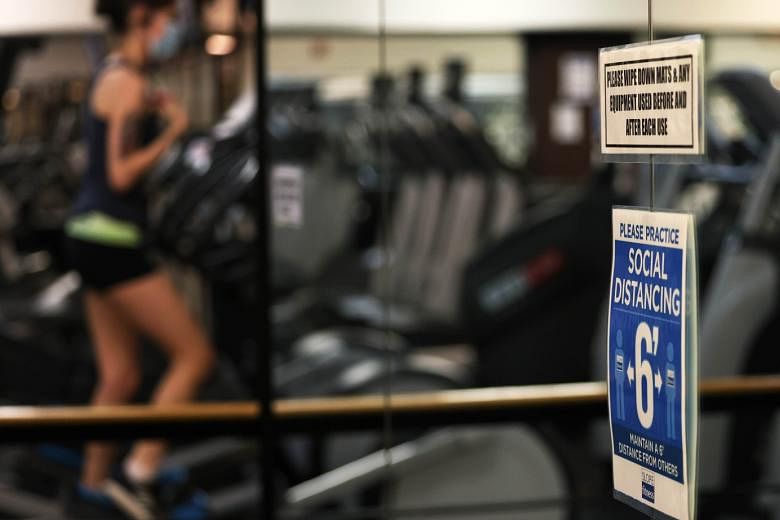One of the few bright spots in a very challenging year has been the monthly e-mails from my budgeting app showing huge declines in my spending.
I can't take much credit for the drops, given all the Covid-19 restrictions and risks that have prevented my family from spending at usual capacity. But still, it is nice to see something moving in the right direction.
The app says we've been saving between US$2,000 (S$2,700) and US$3,500 each month since March. And compared with the same period last year, our credit card balances are down 25 to 30 per cent, led by a complete halt in travel, dining out and my thrice-annual hair-colour appointments.
According to the Bureau of Economic Analysis, categories like clothing, recreation and food services experienced rapid declines in the second quarter of this year, compared with previous quarters. Some of these pandemic spending habits are here to stay, at least for a while.
I estimate that my new lifestyle can save me about US$10,000 a year at no cost to my overall fulfilment. Instead, it can open my bank account up to the things 2020 has led me discover matter more.
SELF-CARE AND GROOMING
I am not giving up on myself, but I don't need all the pricey wellness stuff that Instagrammers have been telling me is essential. You know what is actually essential? Sleep, water and staying off social media.
That said, I did pay over US$100 for a fancy haircut in August. It was my first chop in seven months, and I immediately felt revived.
My grey roots, however, can wait. And they can be handled by a colouring kit in lieu of the salon appointment. I tried the DIY kit once, deemed it a success and now I am hooked.
Manicures will also make a comeback, but they'll be far more seldom.
And as we became more cost-conscious in the pandemic, I learnt by trial that the Target-brand face scrub can be just as effective as the fancy stuff.
Estimated annual savings: US$1,400.
FANCY FOOD BRANDS
I do far more food shopping now than before the pandemic, and it has taught me how to get the most bang for my buck while still eating healthily. The key is to opt for cheaper store-label brands whenever possible. Sales of private-label goods, according to Nielsen, jumped 29 per cent since March - ahead of regular-branded product sales, which grew by 24 per cent. I figure I save more per week by avoiding higher-end brands.
Estimated annual savings: US$1,500.
FAST FASHION
With nowhere super exciting to go these days, my closet has remained the same since March. Once the world reopens for good, I'll be more inclined to buy a new blazer or colourful dress.
But "fast fashion" clothing from the likes of Zara and H&M will no longer be my go-to picks. I've realised that a closet full of clothing is useless. Instead, I plan to invest more in a high-quality, capsule wardrobe - one that is heavy on the tops. Spending more on individual items today can mean saving more money in the long run.
Estimated annual savings: US$250.
WEEKNIGHT TAKE-OUT
In June, restaurants accounted for 1.2 per cent of our overall credit card statement, compared with almost 8 per cent the year prior, when we ate out (or ordered in) some five nights per week. That is hundreds of dollars in savings per month that we don't miss.
Is it easier to order a meal online and have it delivered to your door? Sure. But after being more or less forced to cook these past several months, I've discovered some joys in the ritual.
I love watching my kids watching us prepare dinner. They gather around the counter, building up their appetites, asking "What are you making?" and "Can I help?"
I love it when the smells of roasted garlic and spices fill up our house, reminiscent of when I was growing up.
We're creating great memories and I now can't imagine going back to the old ways of eating.
Estimated annual savings: US$5,000.
WORKOUT CLASSES
Old Farnoosh would blindly drop US$300 a month on fancy fitness classes such as cardio boxing and barre, but in the past six months, I've paid for all but one outdoor workout class due to studio closures.
Instead, I've practised better eating, done some home workouts and started to run more, all which have led to similar results. I do miss barre class, though, which can't quite be replicated at home. So I'll probably go back to attending a handful of those every month in person.
Estimated annual savings: US$1,800.
I'm sure that once the world resumes a greater level of normalcy, we'll revert to our old spending habits. I, for one, can't wait to travel somewhere other than the supermarket.
But the recession has undoubtedly taught me some big lessons about what I care about and what I can manage on my own.
This past month, for example, I replaced my 2011 MacBook with the newest model because working from home all day required it. I've learnt not to wait so long to invest in tech, especially for work. I also paid more for higher-end cookware this summer, making meal prep more enjoyable. Finally, our charitable giving is up in 2020, as the year has made it abundantly clear that with some easy trade-offs, we have more room to give.
BLOOMBERG
•The writer is a financial journalist, author and host of the So Money podcast.

